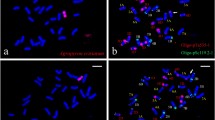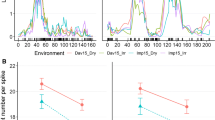Abstract
The time of flowering is critical in determining the adaptation of cereals to different agro-geographic areas, and understanding its genetic control will lead to methodologies for marker-assisted selection and genetic manipulation to fine-tune crops to their environment. In the temperate cereals, three different genetical systems are involved, those controlling vernalization requirement, those determining photoperiod response, and those controlling developmental rate. Vernalization requirement is particularly important as it determines whether wheats (Triticum species) can be winter or spring sown. The vernalization gene Vrn-AI on chromosome SA is the predominant gene determining the spring/winter habit difference in bread wheat and its location and cloning will give rise to novel strategies for genetic manipulation of flowering in wheat and other cereals. Using a set of deletion lines for chromosome SA, Vrn-AI was physically mapped into the region of chromosome SA flanked by deletion breakpoints 0.68 and 0.78. This region was shown to be homoeologous to regions containing the Sh2 vernalization gene of barley (Hordeum vulgare L.) and the Spl gene of rye (Secale cereale L.). Analysis of the chromosome SA deletion lines also showed evidence for a second more proximal flowering time effect located between deletion breakpoints 0.S6 and 0.64.
A strategy for cloning the Vrn gene is to use comparative mapping with rice (Oryza sativa L.) and rice genomic tools for chromosome walking. To this end, the 0.68-0.78 interval was shown to be homoeologous to a region of rice chromosome 3 that contains the flowering time QTL Hd-6, previously mapped in a Nipponbare x Kasalath cross by the Japanese Rice Genome Program, and FL TQ 1, a novel QTL identified by us from analysis of78 F3 families derived from a cross ofIR20 x 63–83. The proximal part of chromosome SA is homoeologous to rice chromosome 9, on which two further flowering time QTL were detected in the IR20 x 63–83 cross. These results suggest that rice contains flowering time genes that may be othologous to wheat loci, and thus does provide a strategy for cloning candidate genes.
Access this chapter
Tax calculation will be finalised at checkout
Purchases are for personal use only
Similar content being viewed by others
Author information
Authors and Affiliations
Editor information
Editors and Affiliations
Rights and permissions
Copyright information
© 2000 Springer Science+Business Media New York
About this chapter
Cite this chapter
Sarma, R.N. et al. (2000). Comparative Mapping of the Wheat Chromosome 5a Vrn-A1 Region with Rice and its Relationship to QTL for Flowering Time. In: Gustafson, J.P. (eds) Genomes. Stadler Genetics Symposia Series. Springer, Boston, MA. https://doi.org/10.1007/978-1-4615-4235-3_22
Download citation
DOI: https://doi.org/10.1007/978-1-4615-4235-3_22
Publisher Name: Springer, Boston, MA
Print ISBN: 978-1-4613-6902-8
Online ISBN: 978-1-4615-4235-3
eBook Packages: Springer Book Archive




